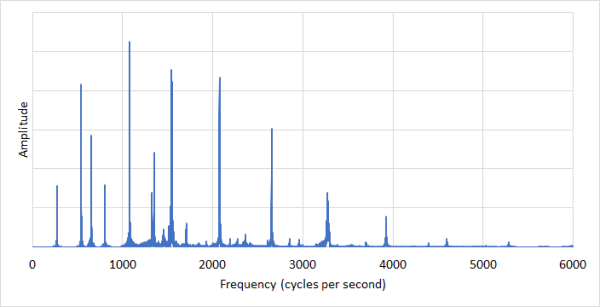In bells, the note we hear (for all bells that are not very small or very large) is a missing fundamental or virtual pitch effect. A set of higher frequency partials generates a sensation of pitch in our ears, auditory nerve or brain. This sensation of pitch is very strong and outweighs any sensation of pitch from individual partials. Because of the particular arrangement of partial frequencies in a bell, the pitch experienced is around an octave below the nominal partial, which is the fifth in order by frequency from the lowest. Since the advent of tuning with forks or electronic equipment, the strike pitch has been assumed to be an exact octave below the nominal. This assumption is not always valid, as we shall see.
Here is the spectrum of the sound of a bell (the 4th at Old Glossop, Derbyshire) with the rim partials highlighted.

The rim partials are those with an anti-node at the soundbow, where the clapper strikes. The lowest rim partial in the plot above (with a frequency of 1078.5Hz) is the nominal.
The spacing of the rim partials depends on the thickness and therefore the weight of the bell. If the bell is heavy and thick for a given nominal, the partials are squashed together, as in the following spectrum:

If the bell is lighter and thinner for the given nominal, the rim partials are stretched apart:

The rim partials always expand or squash together – it is as if that part of the spectrum was drawn on an elastic sheet which is stretched further as the bell gets thinner. The differences in rim partial spacing have been exaggerated for demonstration purposes, the thick and thin spacing is at the limit of the values in my collection of recordings.
Here are three bell sounds for the three spacings of upper partials:
- Rim partials normally spaced
- Rim partials stretched apart (thin bell)
- Rim partials squashed together (thick bell).
The sounds for the thin and thick bells have a different timbre. Experiments done as part of my research show that this difference is interpreted by many listeners as a difference in pitch, which in this demonstration is around half a semitone. However, some listeners don’t hear the difference as a difference in pitch, including, interestingly, bell tuners, whose ears have been trained to hear the individual partial frequencies rather than the holistic pitch effect of all partials.
Because, as explained elsewhere on this website, the rim partials of bells have a fixed relationship, I use the octave nominal tuning, and specifically the interval in cents between the octave nominal and the nominal, to represent the extent to which the rims partials are expanded or squashed together.
There are two practical implications of this difference in timbre or pitch in bells with different octave nominal tuning:
- if a bell has a significantly different octave nominal tuning to other bells in a peal, it will stand out, even if the tuning of the low partials is compatible with the others
- in peals of 10, 12 and higher numbers, the smaller bells are generally cast heavy and thick compared with the tenors, for mechanical reasons (to increase their rotational moment of inertia) and also, it is said, to make their sound more powerful. This can make the small bells sound flat against the tenors.